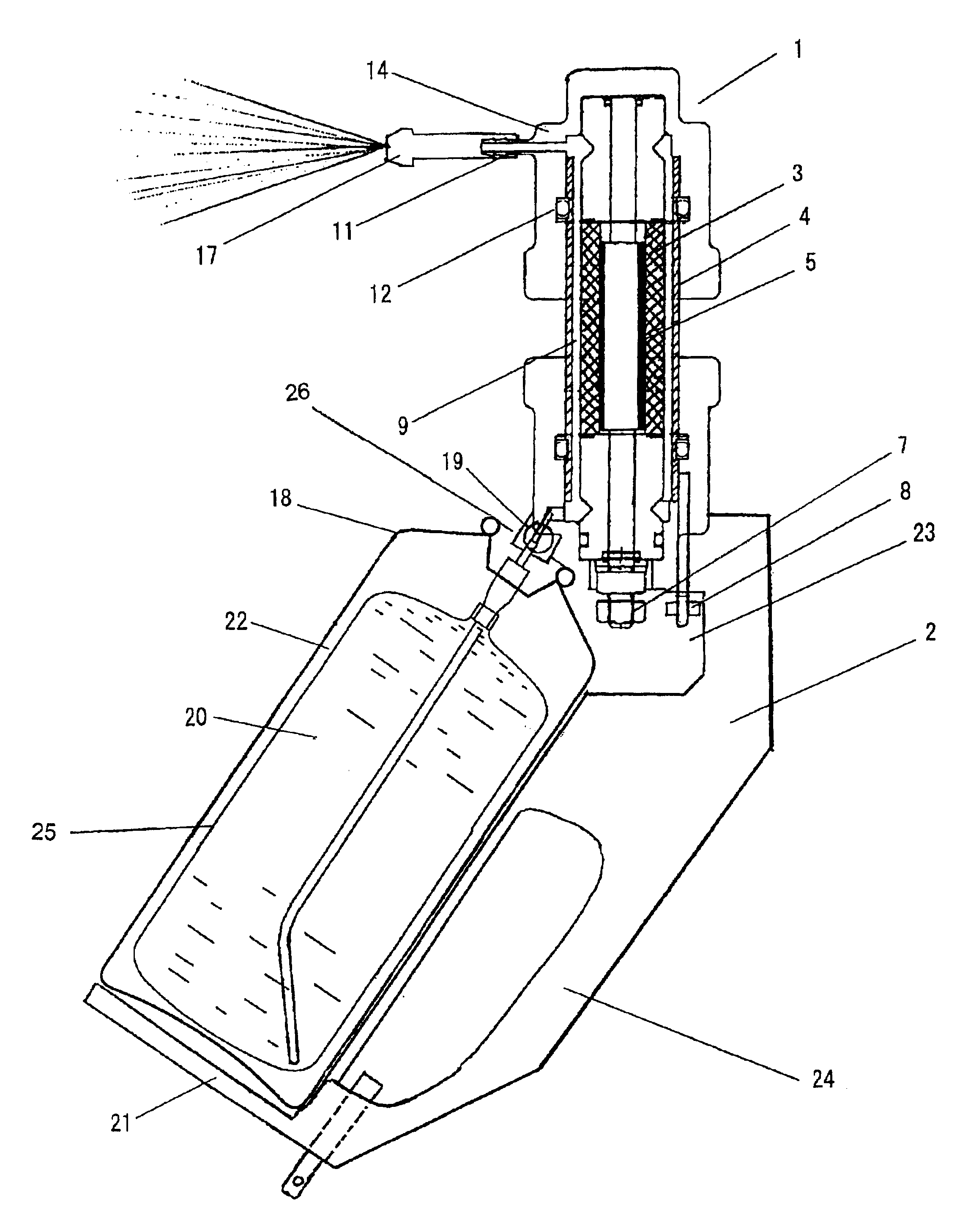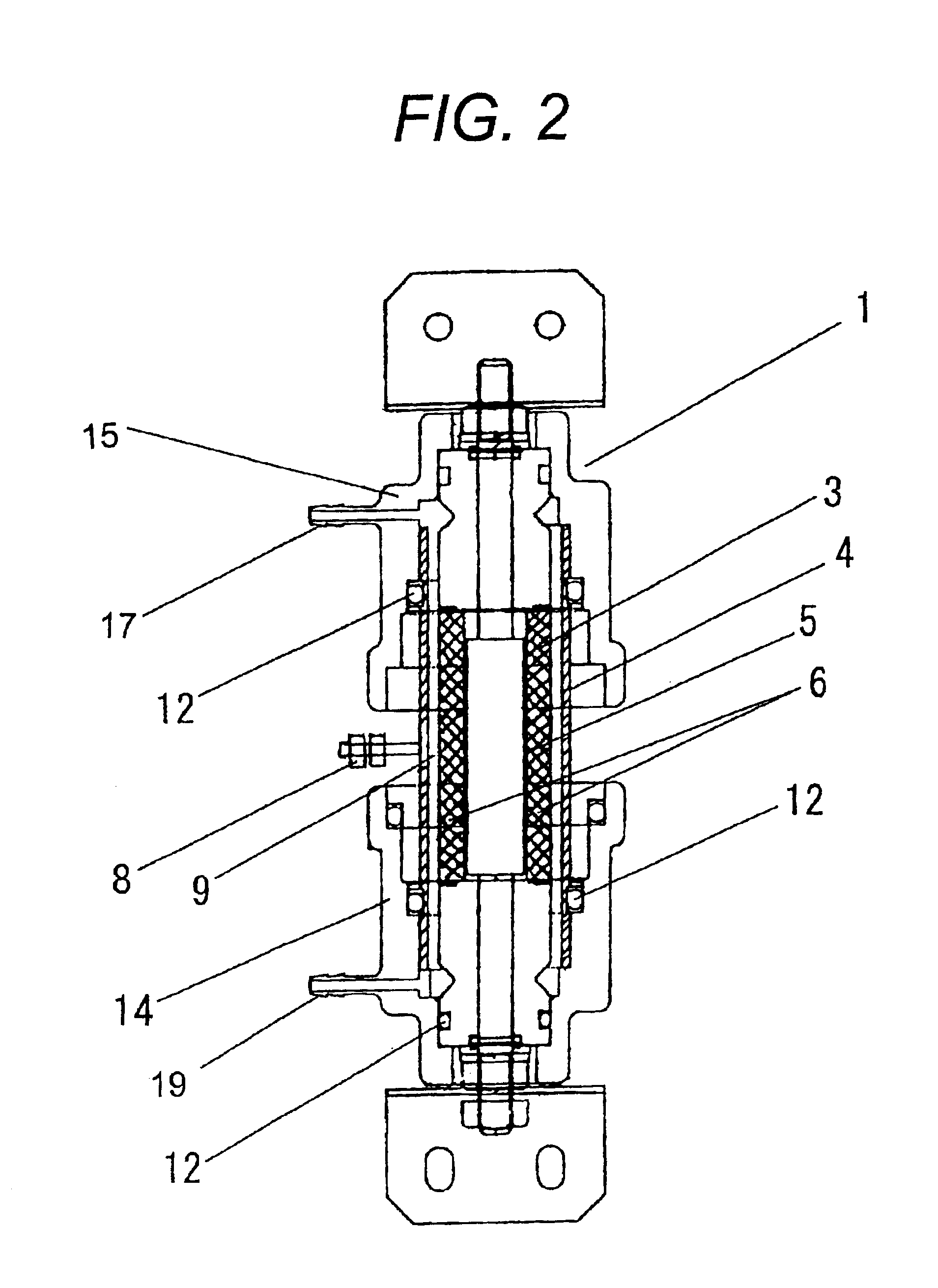Method for generating sterilizing wash water and a portable apparatus thereof
- Summary
- Abstract
- Description
- Claims
- Application Information
AI Technical Summary
Benefits of technology
Problems solved by technology
Method used
Image
Examples
embodiment 1
(Embodiment 1)
[0040]As shown in FIG. 1, in Embodiment 1, a double container (a bag-in-a-can type container), which has been normally used as a pressurizable solution spray container (18) is used.
[0041]A solution (20) containing halogen ions is filled in while the container (18) is detached from a feed connection (19) having a valve, and the valve is opened.
[0042]Then a pressurized atmosphere or pressurized inert gas (22) is filled from the gas inlet (26) to a space between the container (18) and outside the bag (25). The desirable pressure is 0.6 to 1.0 MPa, and in this embodiment an air pressure of 0.9 MPa is set.
[0043]If a container (18) with an anti-corrosive interior is used, the solution (20) containing halogen ions can be directly filled in without using a bag, and the pressurized air or pressurized inert gas can be filled in to the container (18) from the gas inlet (26).
[0044]As the solution containing halogen ions, a chloride or bromide of potassium or sodium is used individ...
embodiment 2
(Embodiment 2)
[0068]The present embodiment is a further compact, lighter and simpler example than Embodiment 1 in which an electrolyzer is contained in a regularly available push-button type spray container. The mode of the embodiment is described in accordance with FIG. 4.
[0069]The electrolyzer (1) is set in between the spray nozzle portion (17) of the push-button type spray container and the container (18). The solution containing halogen ions was passed through a suction pipe (28) and the inter-electrode reaction portion (9) of the electrolyzer (1) while being electrolyzed, and became sterilizing wash water containing active oxygen and a hypo-halogen acid and was sprayed from the spray nozzle (17).
[0070]The nickel-ferrite anode (3) used in the present embodiment was a tubular shape with an electrode surface of 0.3 dm2, a length of 47 mm, and a diameter of 20 mm. The cathode (4) was a titanium pipe and the inter-electrode distance was set to be 1.5 mm. In addition, it was adjusted...
embodiment 3
(Embodiment 3)
[0076]When purified sterilizing water that is atomized through spraying comes in contact with the atmosphere, the active oxygen and hypo-halogen acid are decomposed, and consequently, the concentration of the Free Residual Chlorine may be significantly reduced.
[0077]In Embodiment 3, purified sterilizing water created through electrolyzing in Embodiment 2 was sprayed and its Free Residual Chlorine concentration was measured and compared with the created electrolyzed water.
[0078]Table 3 shows the results “I” was a measurement of the sample, which came out from the nozzle of the sterilizing wash water exit hole (17) having an internal diameter of 2 mm, when it was electrolyzed with an electrolytic current of 3 A in Embodiment 2.
[0079]“II” was measured after collecting 2 ml of it into a glass container and being left for 20 minutes.
[0080]“III” was approximately a 6 ml sample, for which a spray nozzle (17) for hair spray was attached, and was sprayed under the same conditio...
PUM
| Property | Measurement | Unit |
|---|---|---|
| Distance | aaaaa | aaaaa |
| Fraction | aaaaa | aaaaa |
| Fraction | aaaaa | aaaaa |
Abstract
Description
Claims
Application Information
 Login to View More
Login to View More - R&D
- Intellectual Property
- Life Sciences
- Materials
- Tech Scout
- Unparalleled Data Quality
- Higher Quality Content
- 60% Fewer Hallucinations
Browse by: Latest US Patents, China's latest patents, Technical Efficacy Thesaurus, Application Domain, Technology Topic, Popular Technical Reports.
© 2025 PatSnap. All rights reserved.Legal|Privacy policy|Modern Slavery Act Transparency Statement|Sitemap|About US| Contact US: help@patsnap.com



